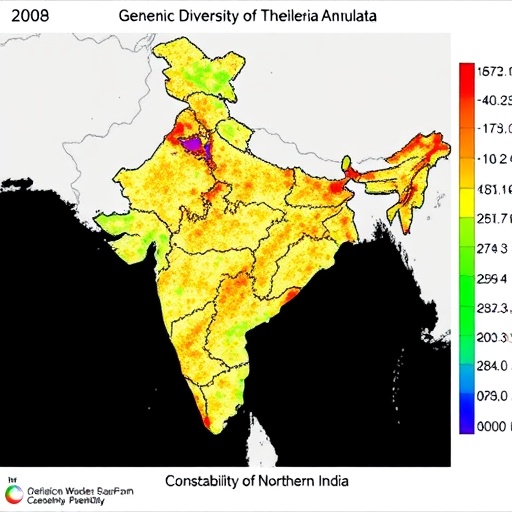
The impact of weather on the breeding success of avian species has emerged as a critical area of research within the field of ecology. Recent findings from a long-term study conducted by Arct et al. underscore the complex interactions between climatic variables and breeding performance in birds, revealing an intricate web of influences that could have significant implications for avian populations in the context of climate change. This study, slated for publication in 2025, provides a comprehensive examination of how variations in temperature, precipitation, and extreme weather events correlate with breeding metrics such as nesting success and chick survival.
Avian breeding performance is a multifaceted phenomenon influenced by a range of environmental factors. The study by Arct and colleagues contributes valuable insights into this domain, highlighting the pivotal role of weather conditions in shaping reproductive outcomes. To grasp the significance of these findings, it is essential to understand the biological and ecological frameworks that govern avian breeding strategies, including timing, location, and parental investment. The interplay of these factors with unpredictable weather patterns is of paramount importance, particularly in the face of global climate change.
As the research reveals, weather patterns significantly influence food availability and habitat conditions, both of which are critical for successful breeding. For instance, milder spring temperatures can lead to an earlier onset of breeding, which may be advantageous for some species by aligning nesting periods with peaks in food supply. However, shifts toward hot and unpredictable weather can create mismatches in timing, potentially compromising the survival of hatchlings and fledglings. This study meticulously correlates weather data with breeding performance metrics across various avian species, providing a broad perspective on these dynamics.
Furthermore, the long-term nature of the study adds a layer of robustness to the findings. By gathering data over extended periods, the researchers were able to observe trends and patterns that shorter-term studies might miss. This longitudinal approach is particularly crucial when examining climate change, as it allows for the detection of gradual shifts in breeding performance that could indicate broader ecological changes. Seasonal variations, once stable, may now appear erratic, forcing avian species to adapt rapidly or face population declines.
Another significant aspect of the study is its exploration of extreme weather events, such as storms and droughts, which have become increasingly frequent due to climate change. These events can drastically alter breeding habitats, either by flooding nests or by reducing the availability of food resources. The authors provide compelling evidence that these extreme conditions result in reduced nesting success and lower rates of chick survival across multiple species. This insight is particularly alarming as it suggests that some avian populations may struggle to maintain their numbers in the face of ongoing climatic disruptions.
The methodological rigor of the study deserves attention. The researchers employed a combination of field surveys, remote sensing technology, and statistical modeling to analyze the interactions between weather variables and avian breeding success metrics. This multidisciplinary approach not only enhances the credibility of their findings but also sets a precedent for future research in the field. By integrating technology with traditional ecological methods, the study paves the way for a comprehensive understanding of how avian species respond to their changing environments.
The implications of this research extend beyond the academic community. For conservationists, the insights provided by Arct et al. can inform management practices aimed at protecting vulnerable bird populations facing the dual challenges of habitat loss and climate change. By recognizing the links between weather variability and breeding outcomes, stakeholders can develop more adaptive strategies that account for these changing conditions. This proactive approach is essential for safeguarding the future of numerous avian species.
Moreover, public awareness and engagement are critical components of effective conservation. The findings of this study can serve as a focal point for public education campaigns aimed at highlighting the importance of biodiversity and the threats posed by climate change. As citizens become more informed about how weather influences their local bird populations, they may be more inclined to support conservation efforts and policies that address climate change and habitat preservation.
Importantly, the study does not only focus on negative outcomes; it also explores potential adaptive strategies that avian species might employ in response to changing weather patterns. Some birds exhibit remarkable behavioral flexibility, adjusting their nesting locations or altering their reproductive timing in response to environmental cues. Understanding these adaptive behaviors is crucial not only for the survival of these species but also for predicting their responses to future climatic changes.
As the world grapples with the reality of climate change, studies like that of Arct et al. are vital. They remind us of the intricate connections within ecosystems and the cascading effects that climate can have on wildlife. This pivotal research acts as a clarion call for increased scientific inquiry and conservation efforts. By furthering our understanding of these dynamics, we can better predict future challenges and mitigate the impacts of climate change on avian populations.
In conclusion, the forthcoming study on the impact of weather conditions on avian breeding performance by Arct and colleagues represents a significant contribution to ecological research. By illuminating the relationship between changing climatic variables and bird reproduction, this work not only advances scientific knowledge but also serves as a crucial resource for conservation and policy-making efforts. The findings underscore the urgent need to address climate change, not just for the sake of avian species but for the health of entire ecosystems.
The complex and interplay of environmental stresses faced by avian species poses significant challenges that cannot be overlooked. The urgency of the situation requires immediate action from multiple stakeholders, including scientists, policymakers, and the general public. By taking a comprehensive approach that combines research, conservation, and education, we can work towards ensuring that avian populations continue to thrive in a rapidly changing world. The future of birds and the ecosystems they inhabit depends on our collective response to the environmental challenges we face.
In summary, this research not only sheds light on how avian species are performing under changing weather conditions but also emphasizes the need for ongoing monitoring and adaptive management in the face of climate variability. The lessons learned from this study can be applied broadly across species and ecosystems, reinforcing the interconnectedness of all life on Earth as we navigate these challenging times together.
Subject of Research: The impact of weather conditions on avian breeding performance.
Article Title: The impact of weather conditions on avian breeding performance: insights from a long-term study.
Article References: Arct, A., Martyka, R., Miler, K. et al. The impact of weather conditions on avian breeding performance: insights from a long-term study. Front Zool 22, 23 (2025). https://doi.org/10.1186/s12983-025-00569-z
Image Credits: AI Generated
DOI: 10.1186/s12983-025-00569-z
Keywords: avian breeding performance, weather conditions, climate change, nesting success, ecological research, conservation, avian populations, reproductive strategies.
Tags: avian reproductive successbreeding performance and weather relationshipsclimate change effects on wildlifeclimate variability and animal behaviorecological factors in bird reproductionenvironmental influences on avian speciesfood availability for birdshabitat conditions and breedinglong-term ecological studiesnesting success and chick survivaltemperature and precipitation effects on birdsweather impact on bird breeding




